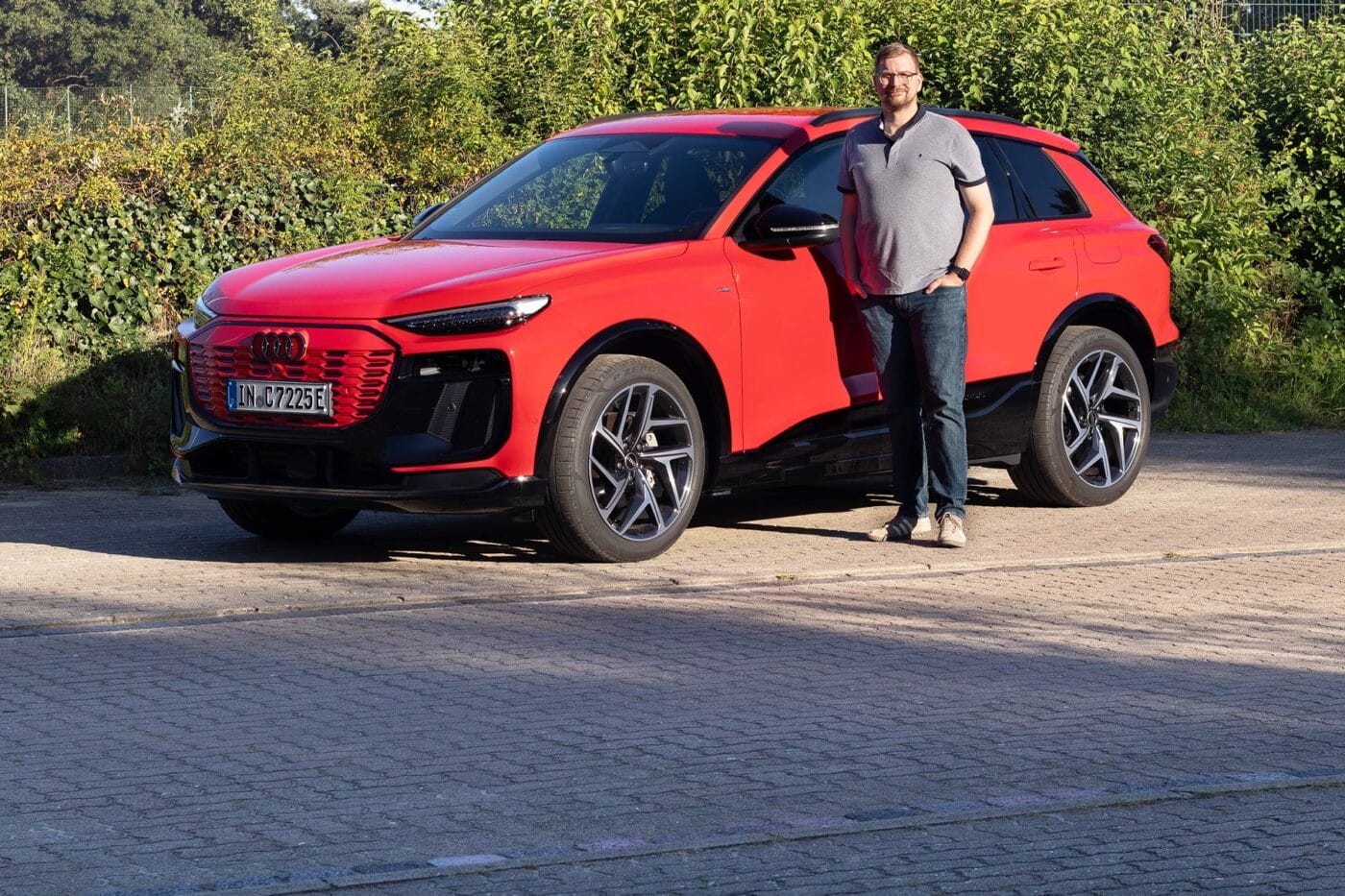
Audi Q6 e-tron quattro on test: A piece of ‘Vorsprung durch Technik’ returns
Audi and electric mobility – that was a complicated relationship for quite some time. The e-tron quattro, later continued as the Q8 e-tron and now discontinued, was an important signal but technically more of a bridge. The Q4 e-tron, which sits on Volkswagen’s MEB platform, struggles to stand out significantly from its (cheaper) sister models. And the e-tron GT, as fascinating as it is, carries more Porsche genes than Audi DNA.
The ‘Premium Platform Electric’ (PPE), developed jointly with Porsche over the past years, aims to change that, together with the new E3 1.2 electronic architecture. The goal: higher efficiency, faster charging times and noticeably more modern software. Audi wants to stop following the market and start setting trends again. The Q6 e-tron is the first model from the VW Group to use this new platform. The series is also intended to form the technological spearhead of Audi’s portfolio.
Familiar Audi design
While Audi is breaking new ground technically, the carmaker stays true to its design language. Like the Q8 e-tron before it, the Q6 e-tron features a long wheelbase and short overhangs. Its dimensions: 4.77 metres long, 1.94 metres wide and 1.69 metres high, with a 2.90-metre wheelbase.
At the front, the closed, three-dimensionally sculpted Singleframe dominates. The main headlights sit hidden in the air intakes; the high-mounted lighting units serve only as LED daytime running lights. Thanks to the pixel technology, numerous light signatures are possible here and at the rear.
From the side, the black trim element on the doors stands out. It symbolically marks the position of the battery – a design cue dating back to former design chief Marc Lichte. The gently sloping roofline and subtly emphasised shoulder line make the Q6 look more elegant than the larger Q8 e-tron. The bulky rear, with its full-width light bar, appears less refined. From every angle, the Q6 e-tron is unmistakably an Audi – though it doesn’t particularly stand out.

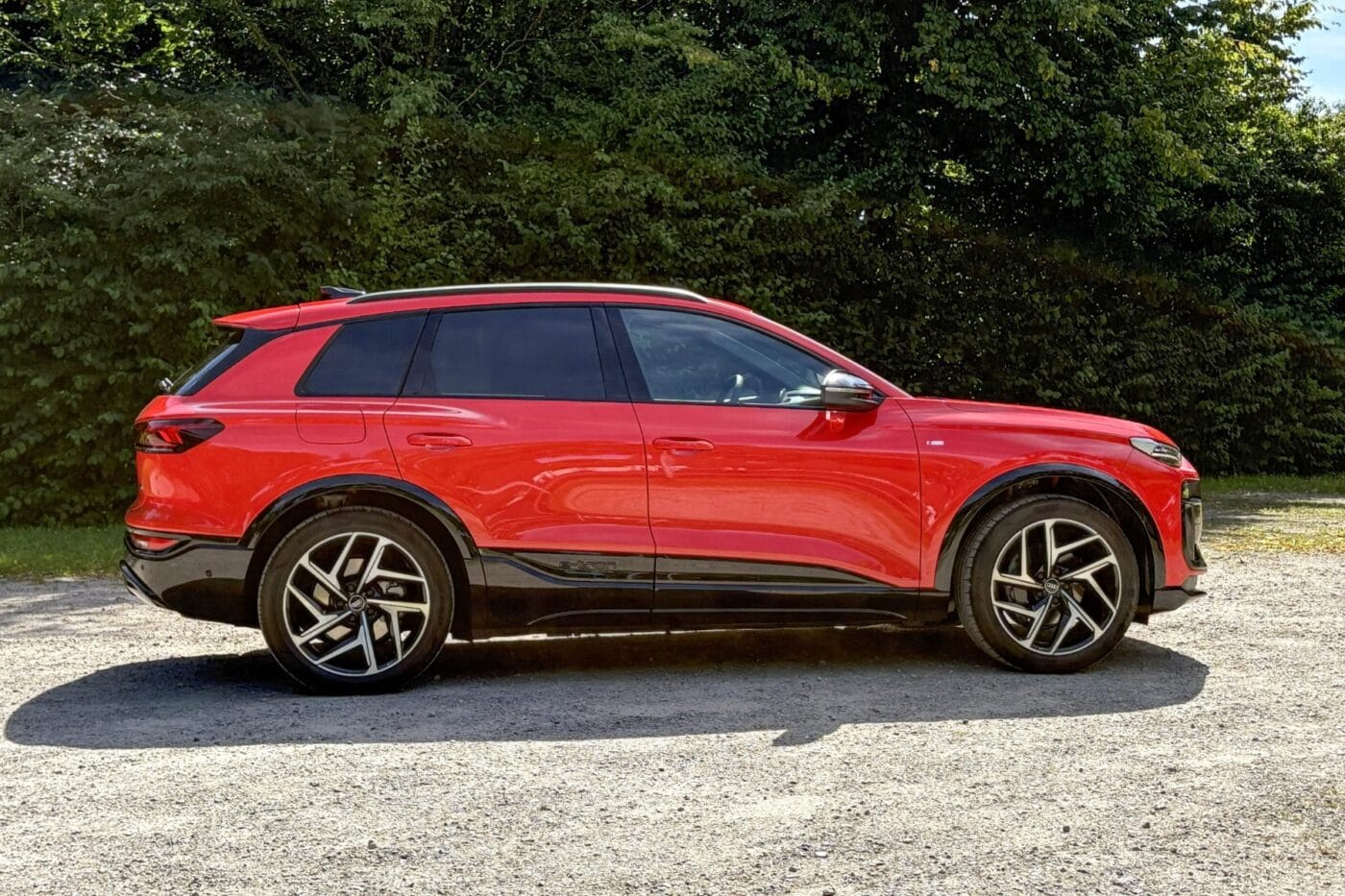

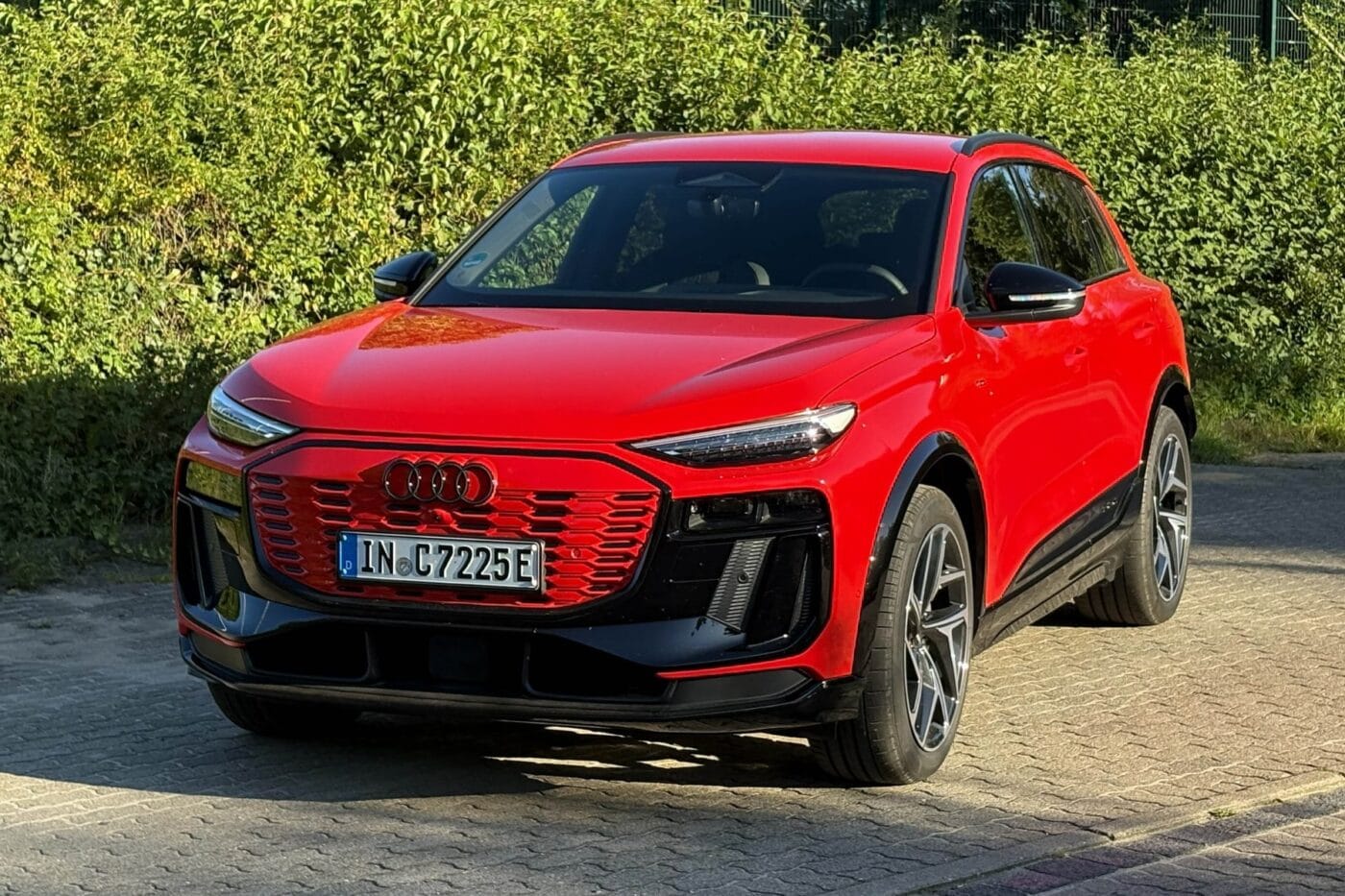
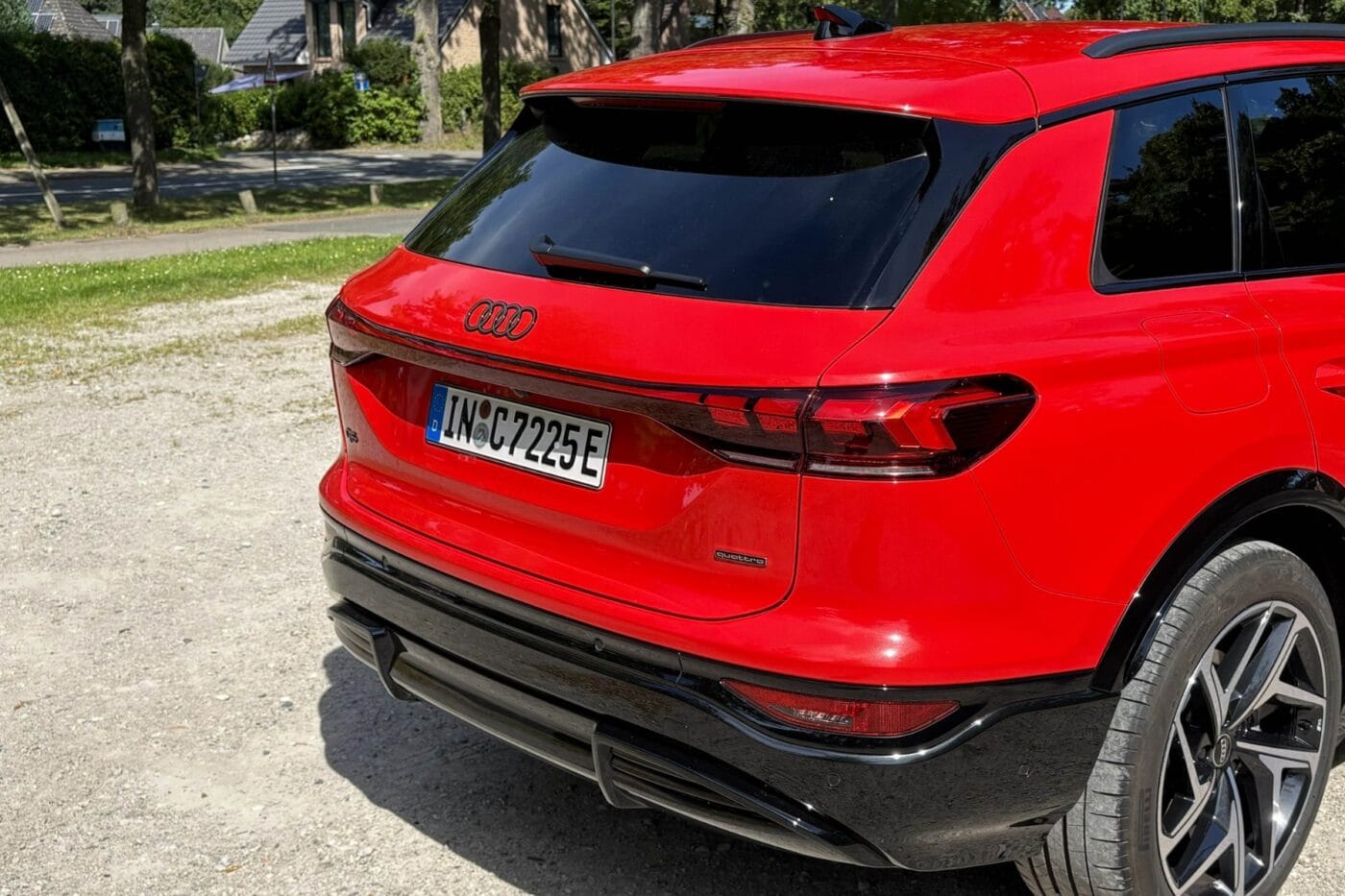

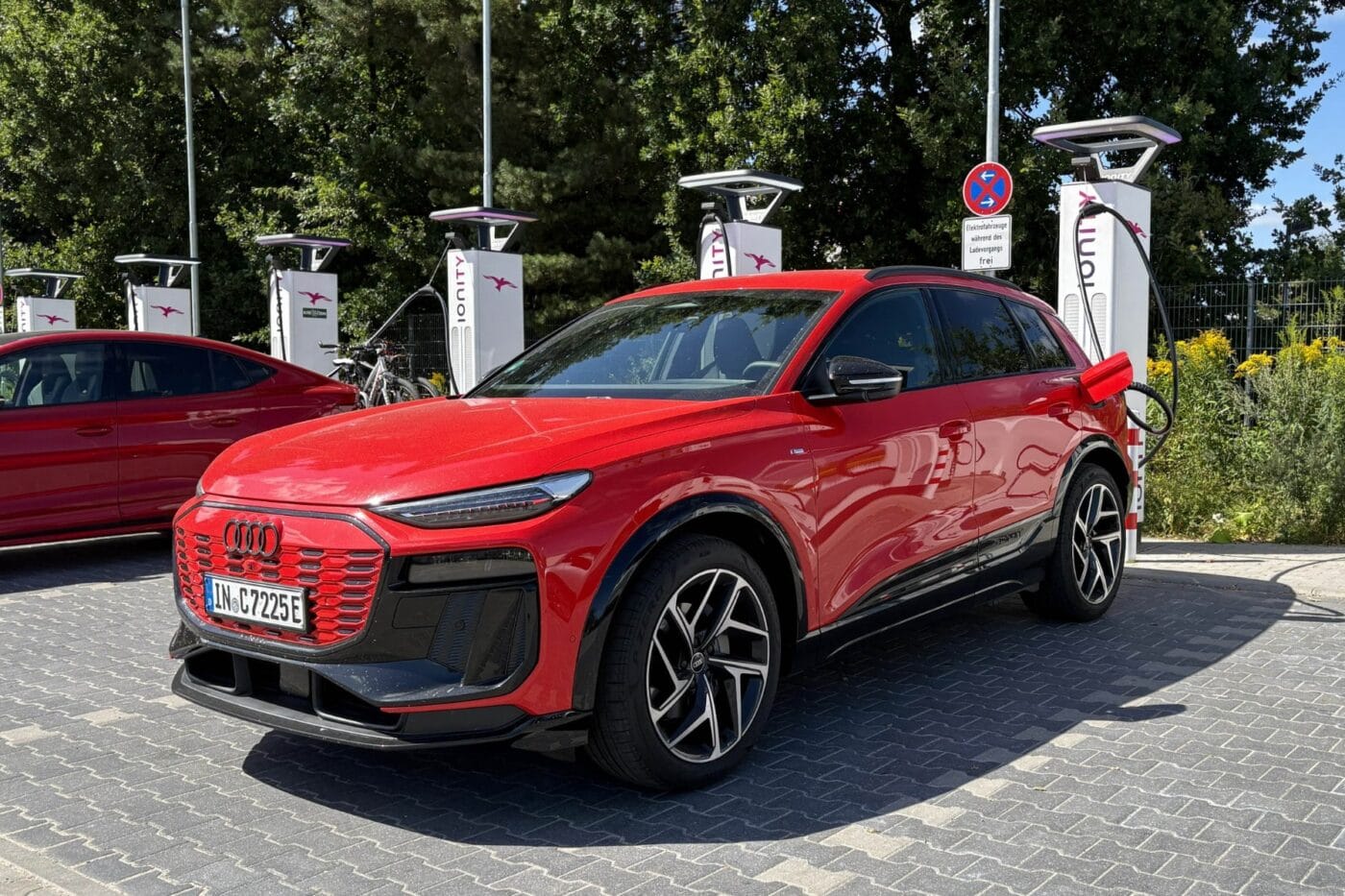

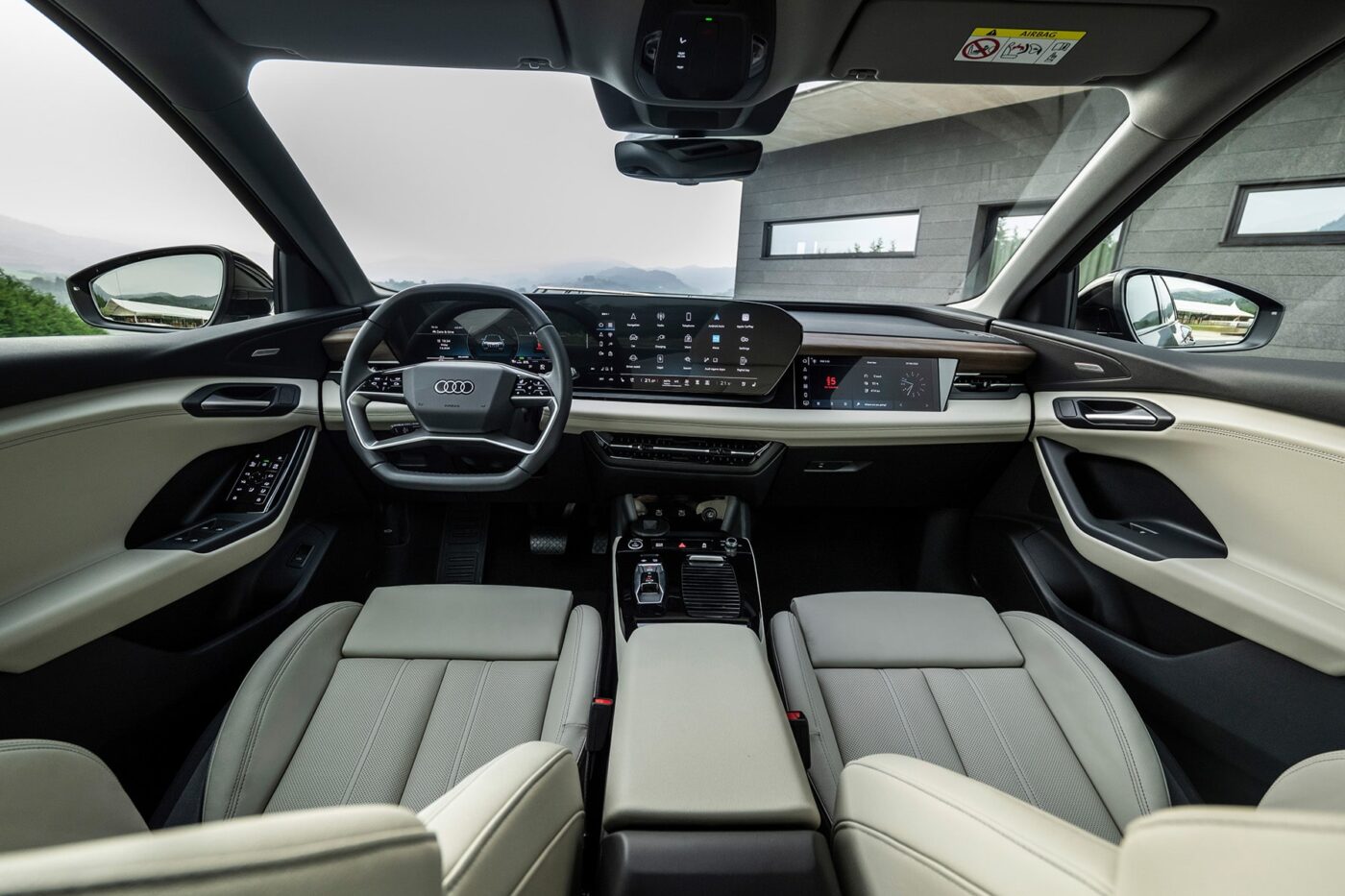
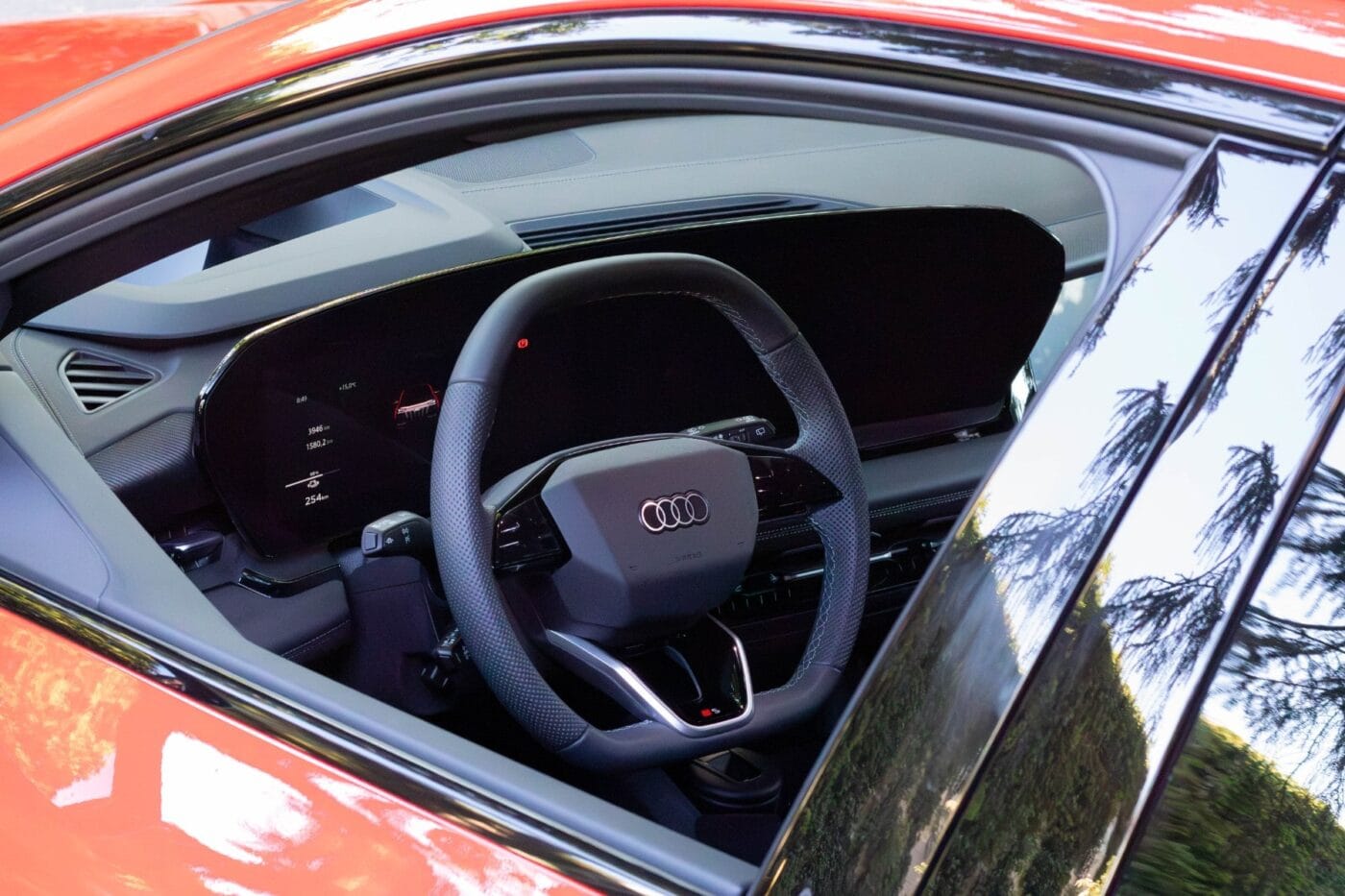
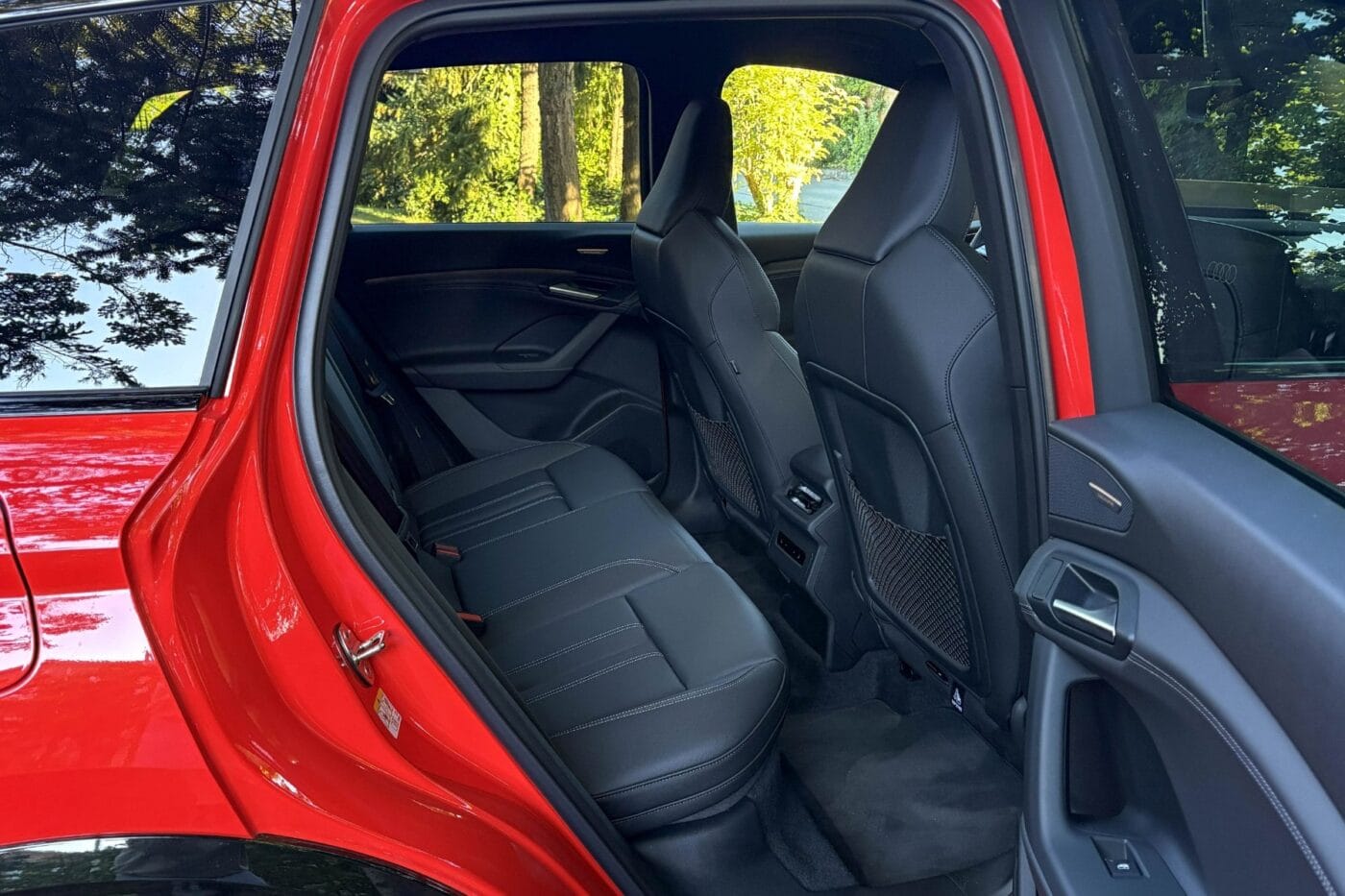
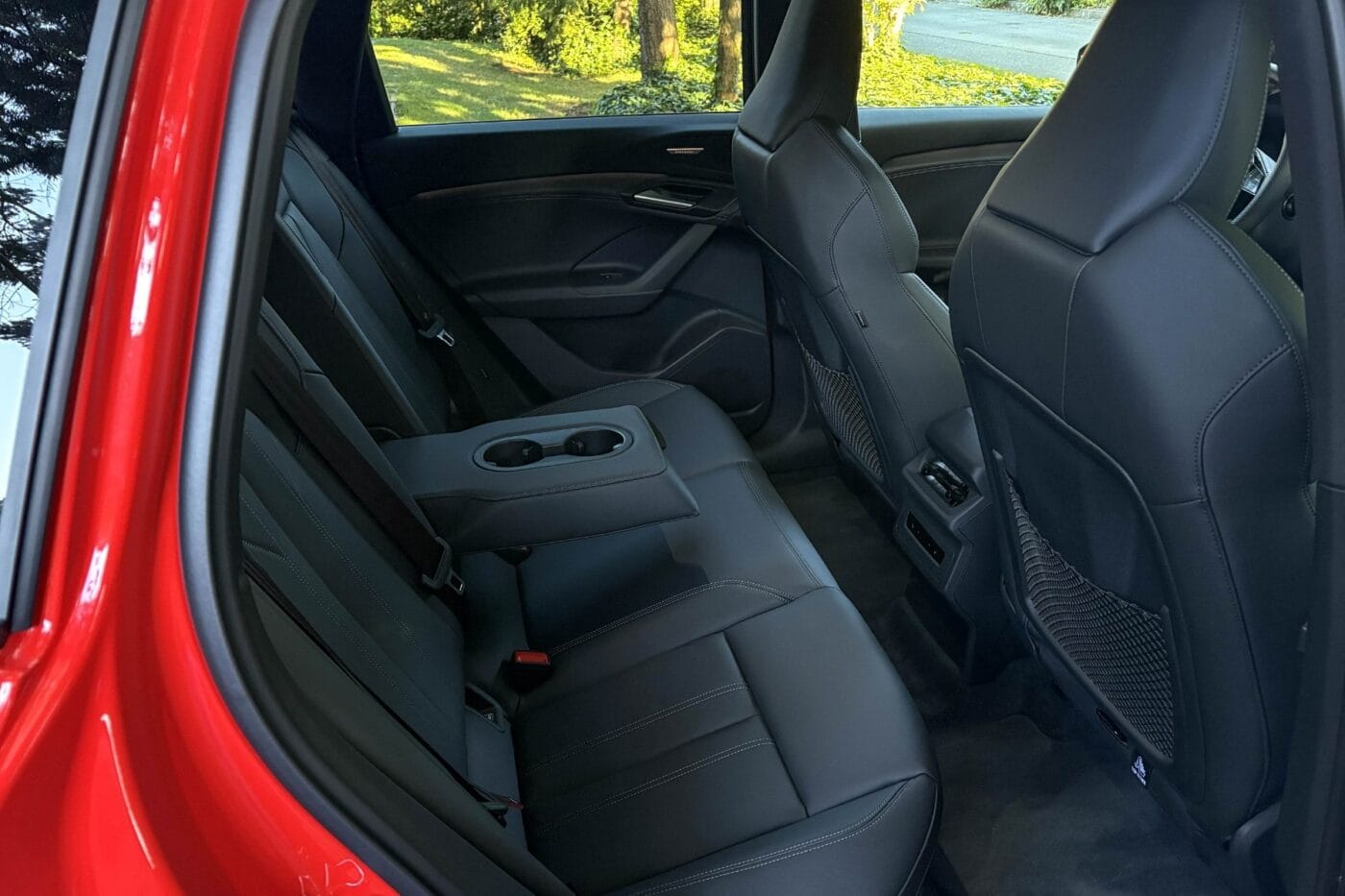


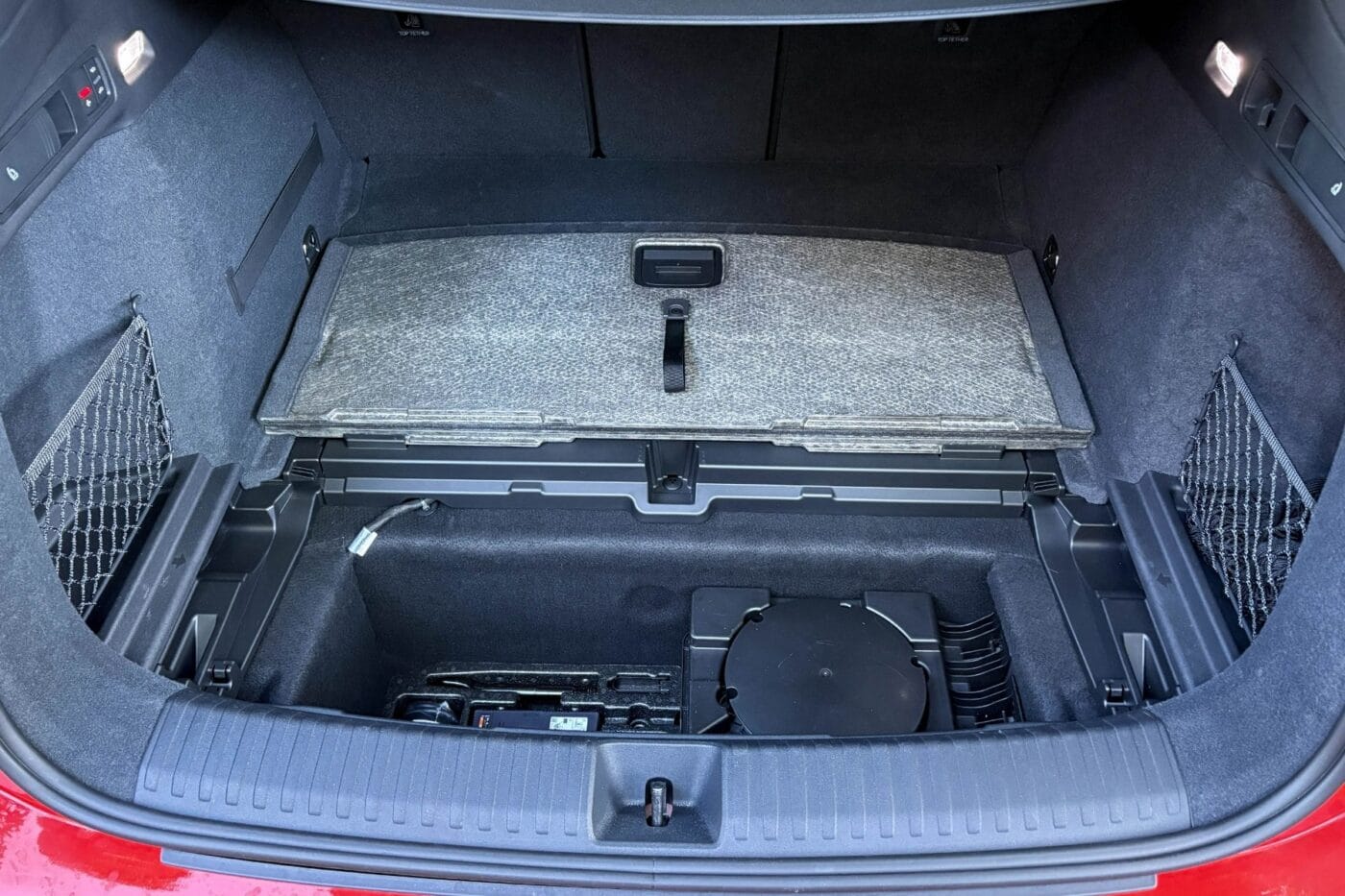

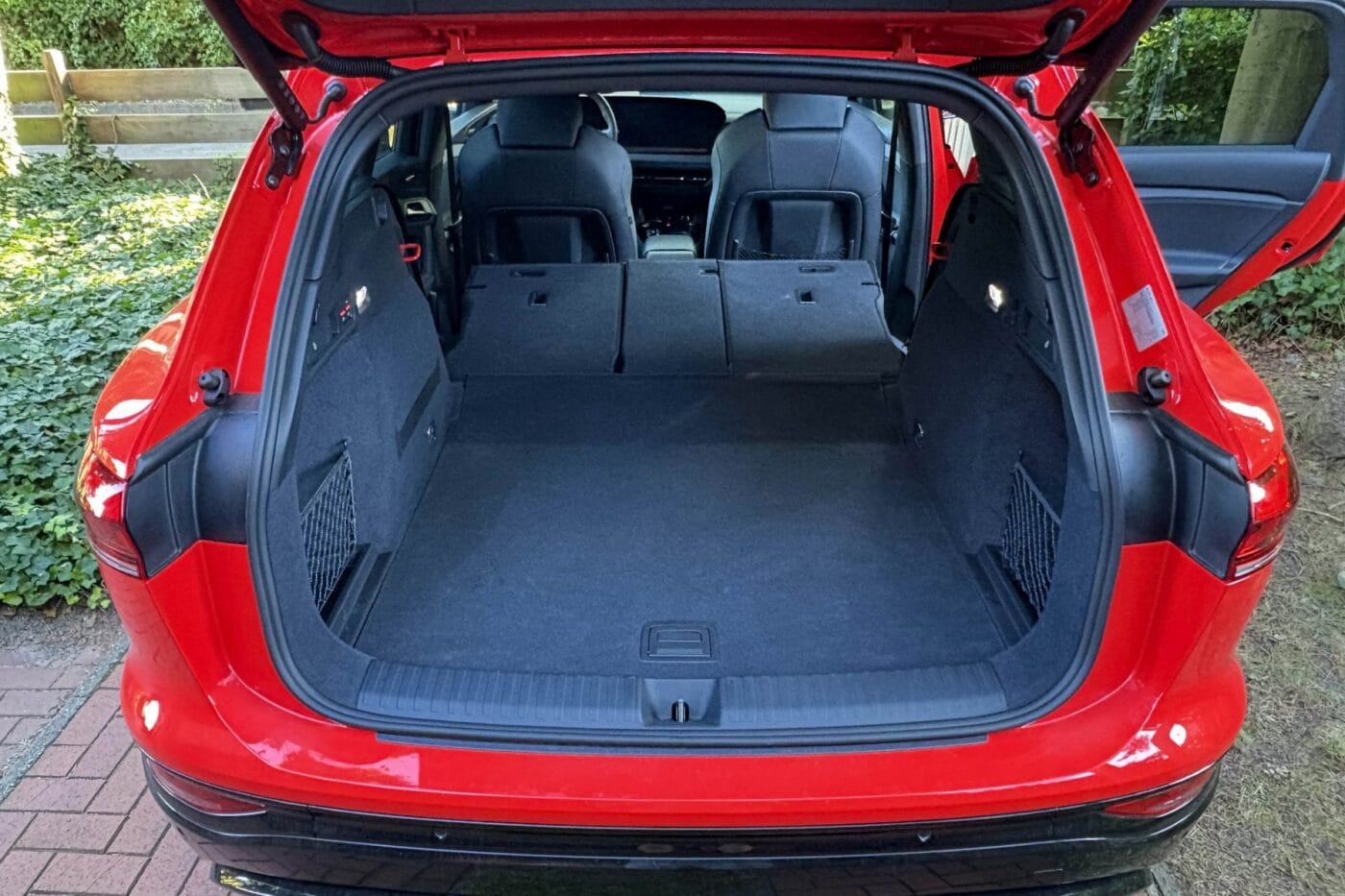

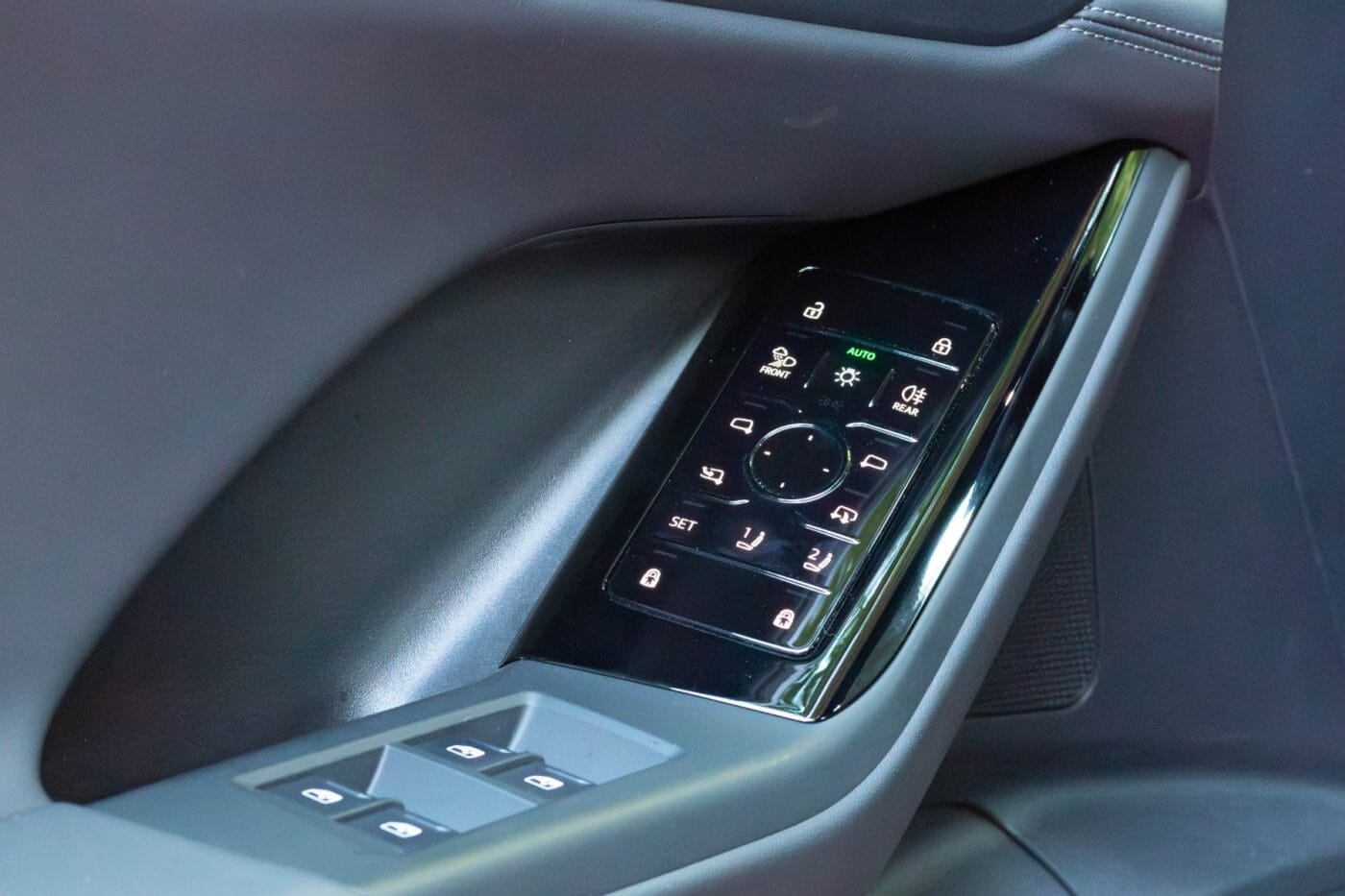


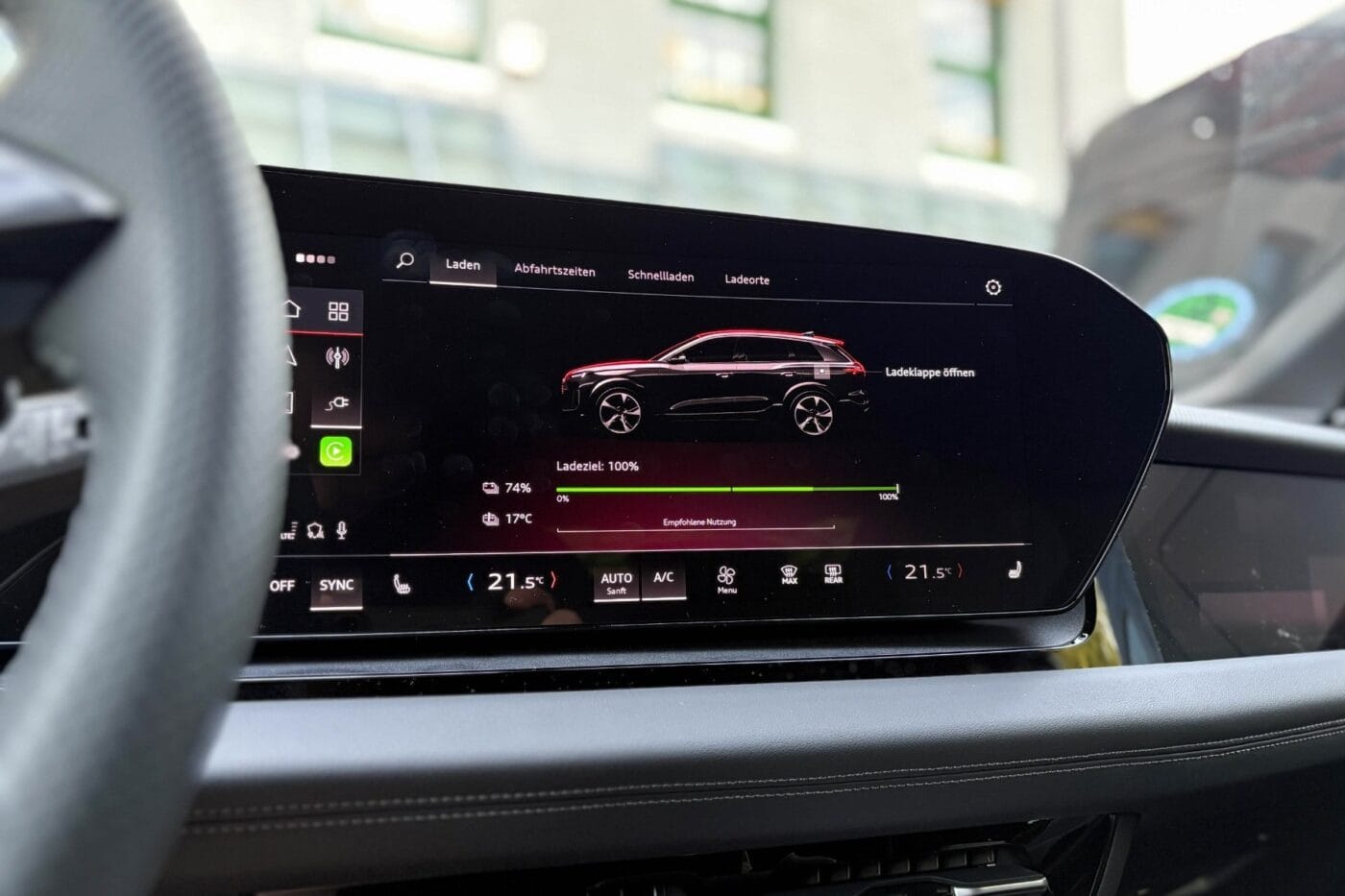
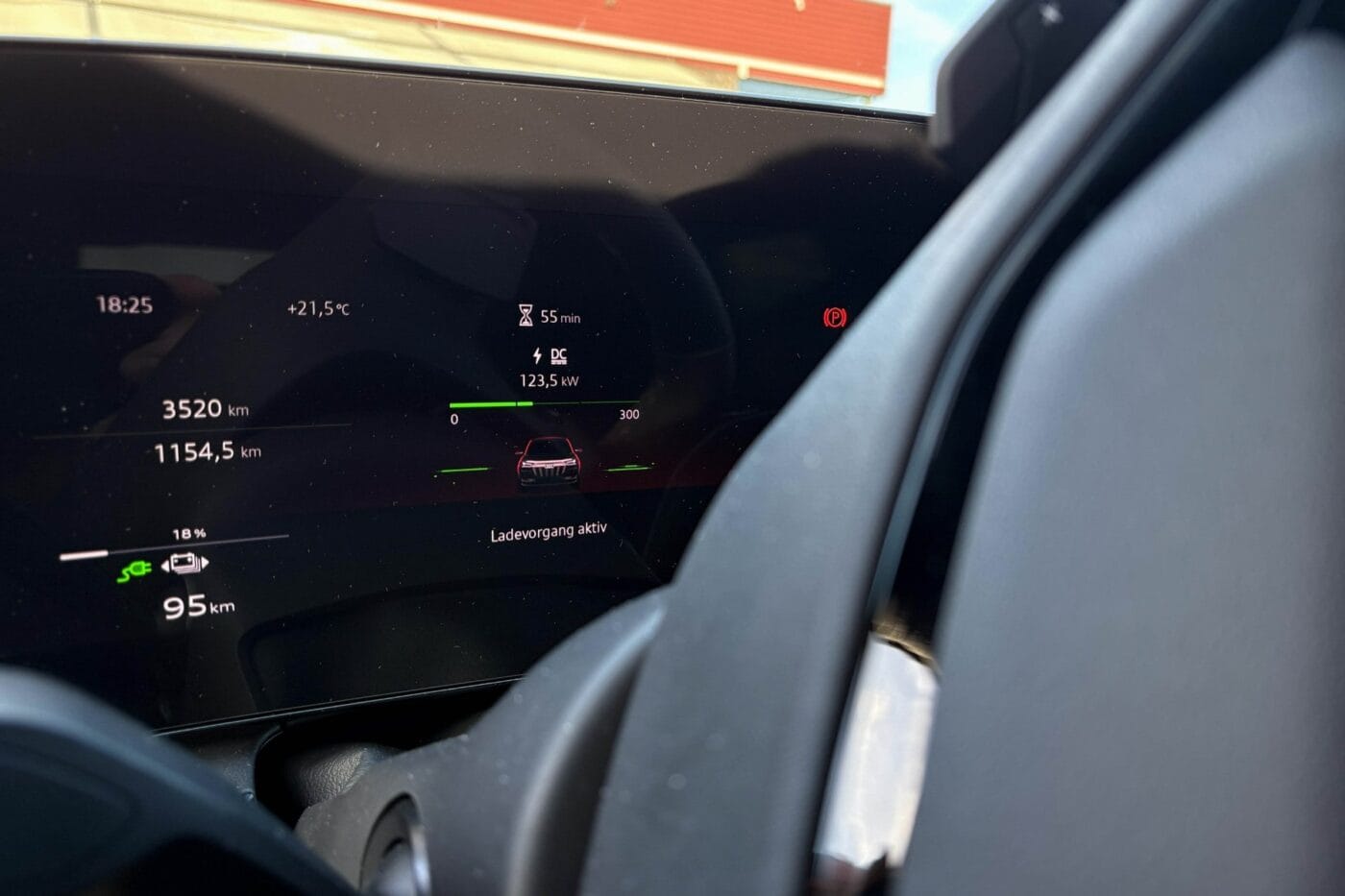
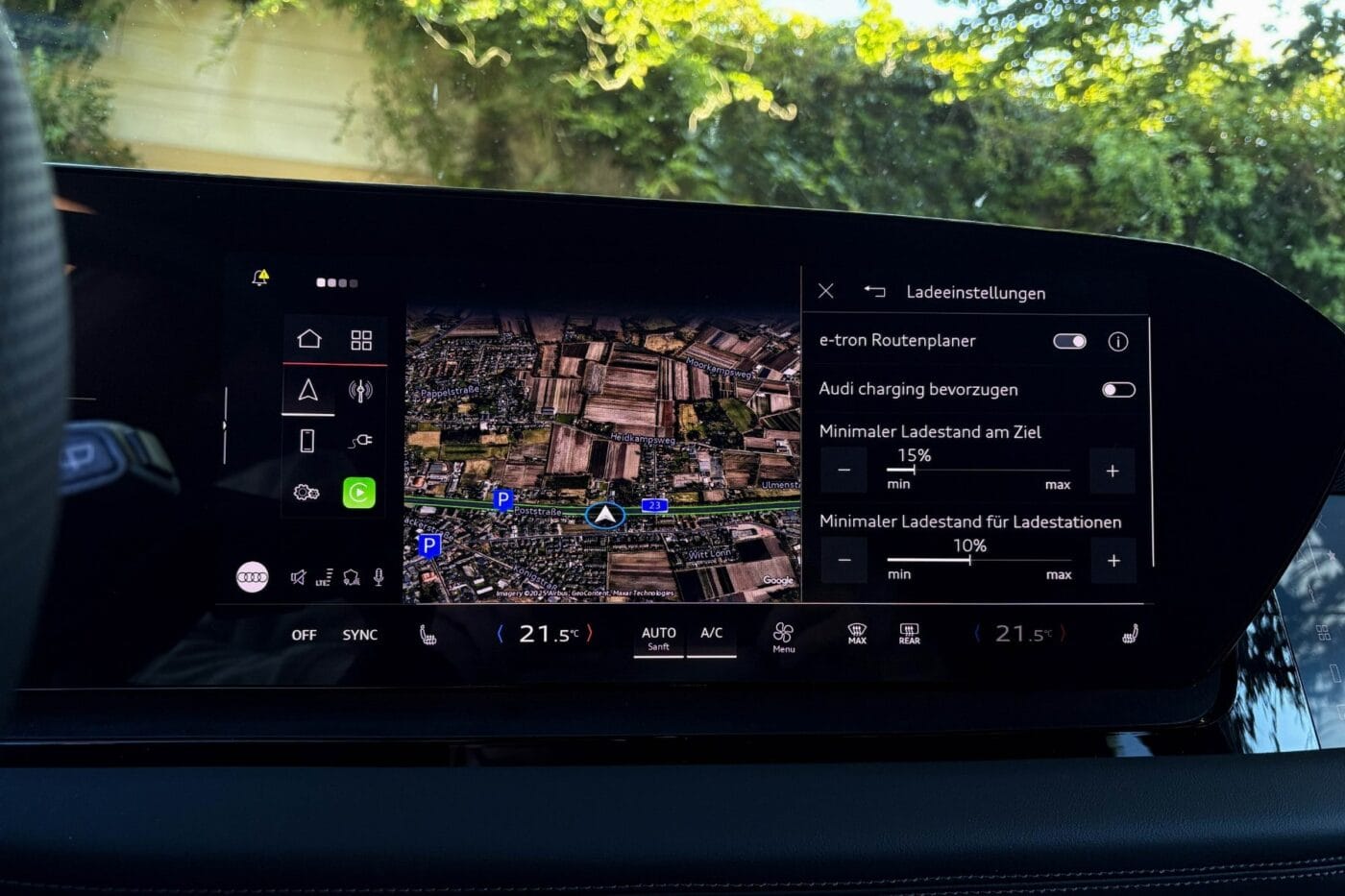
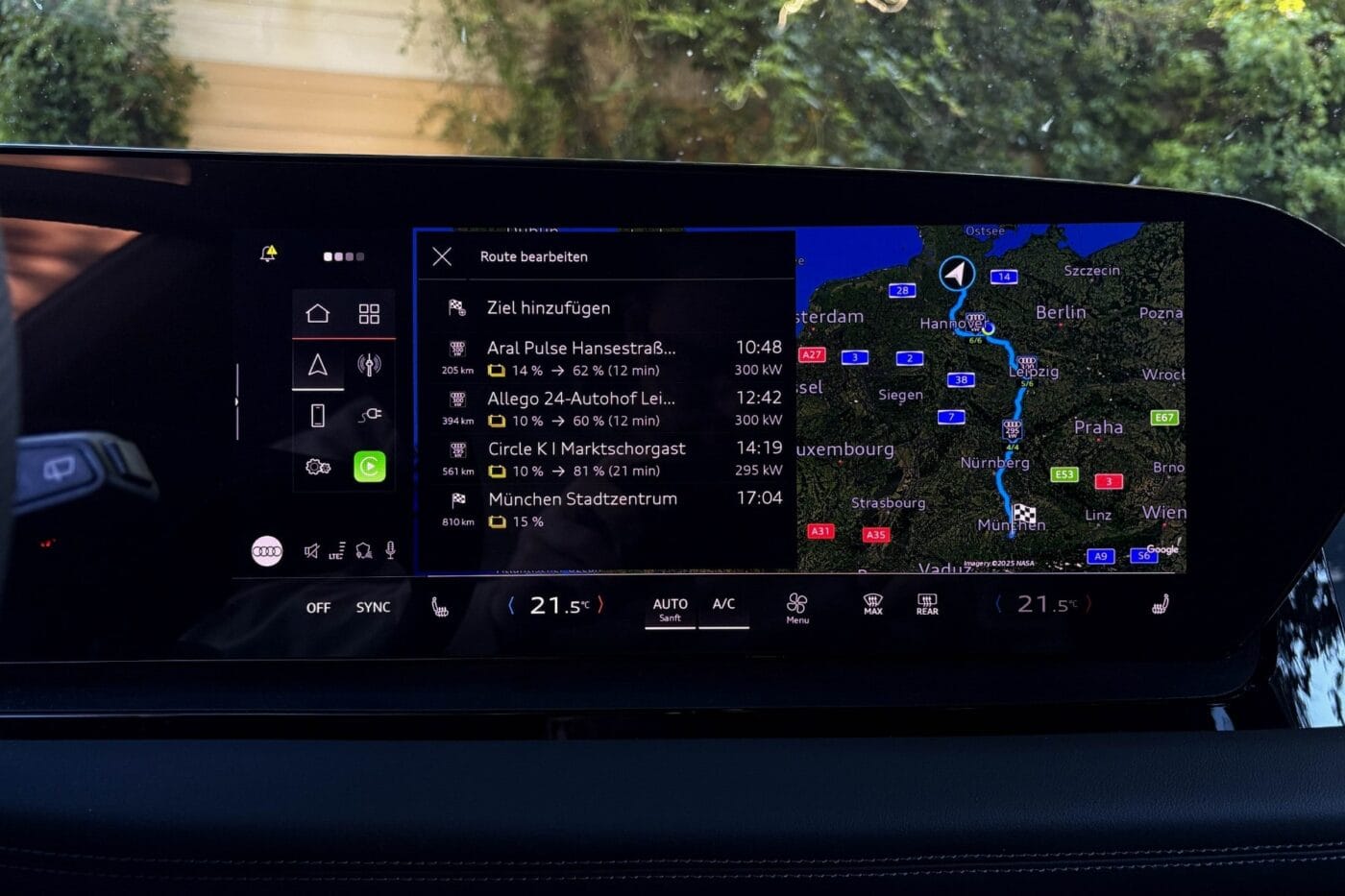
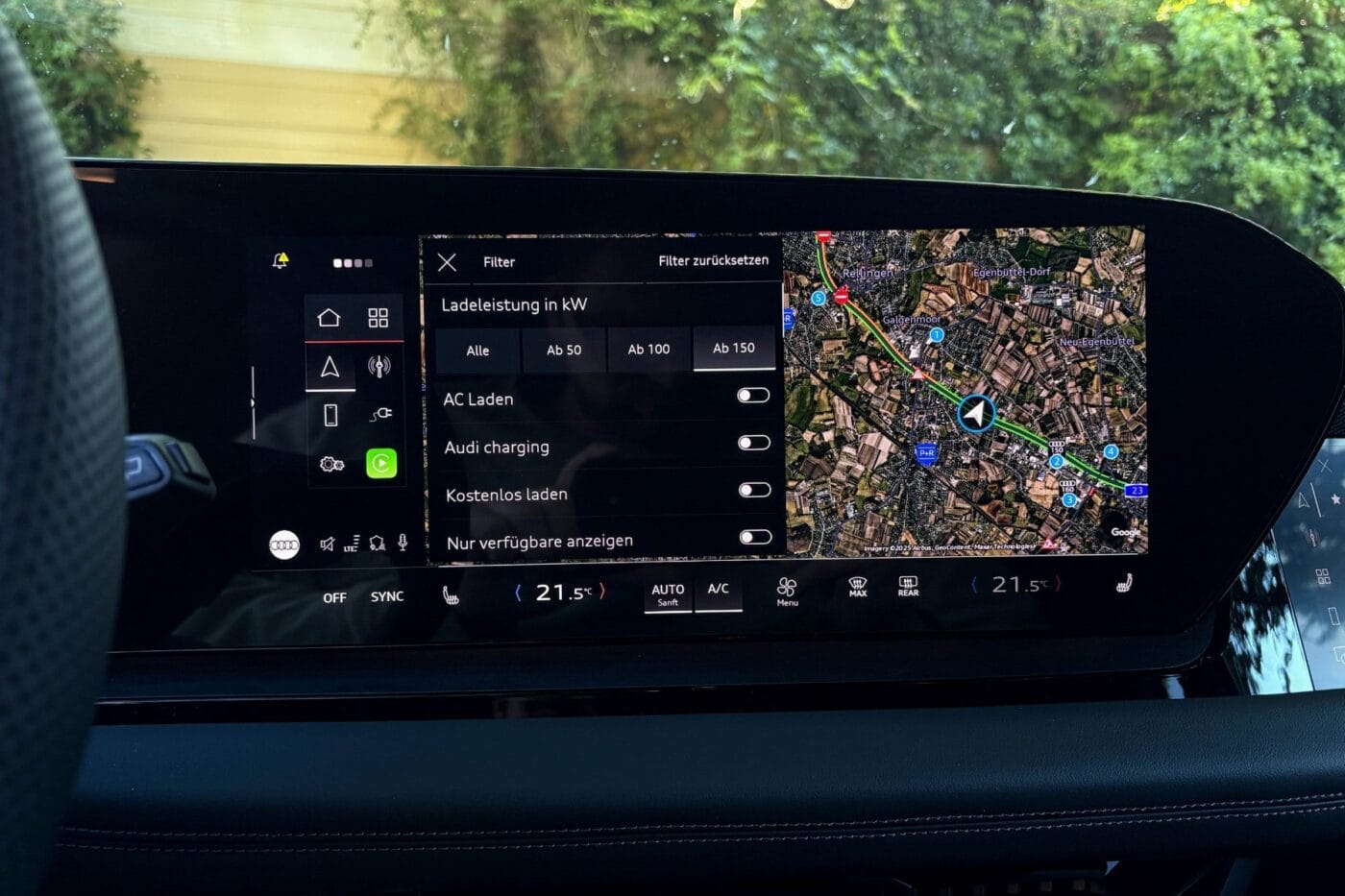
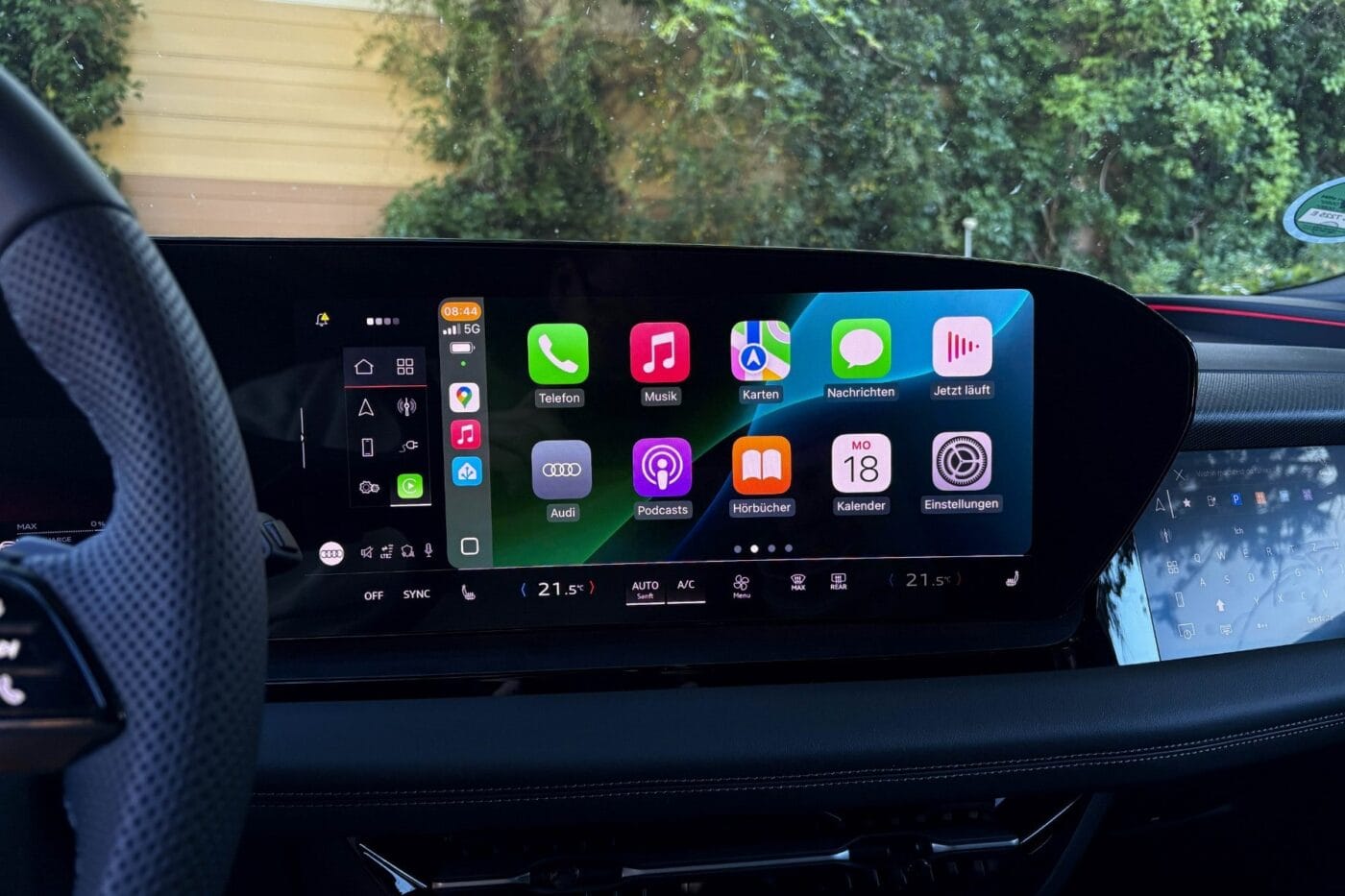
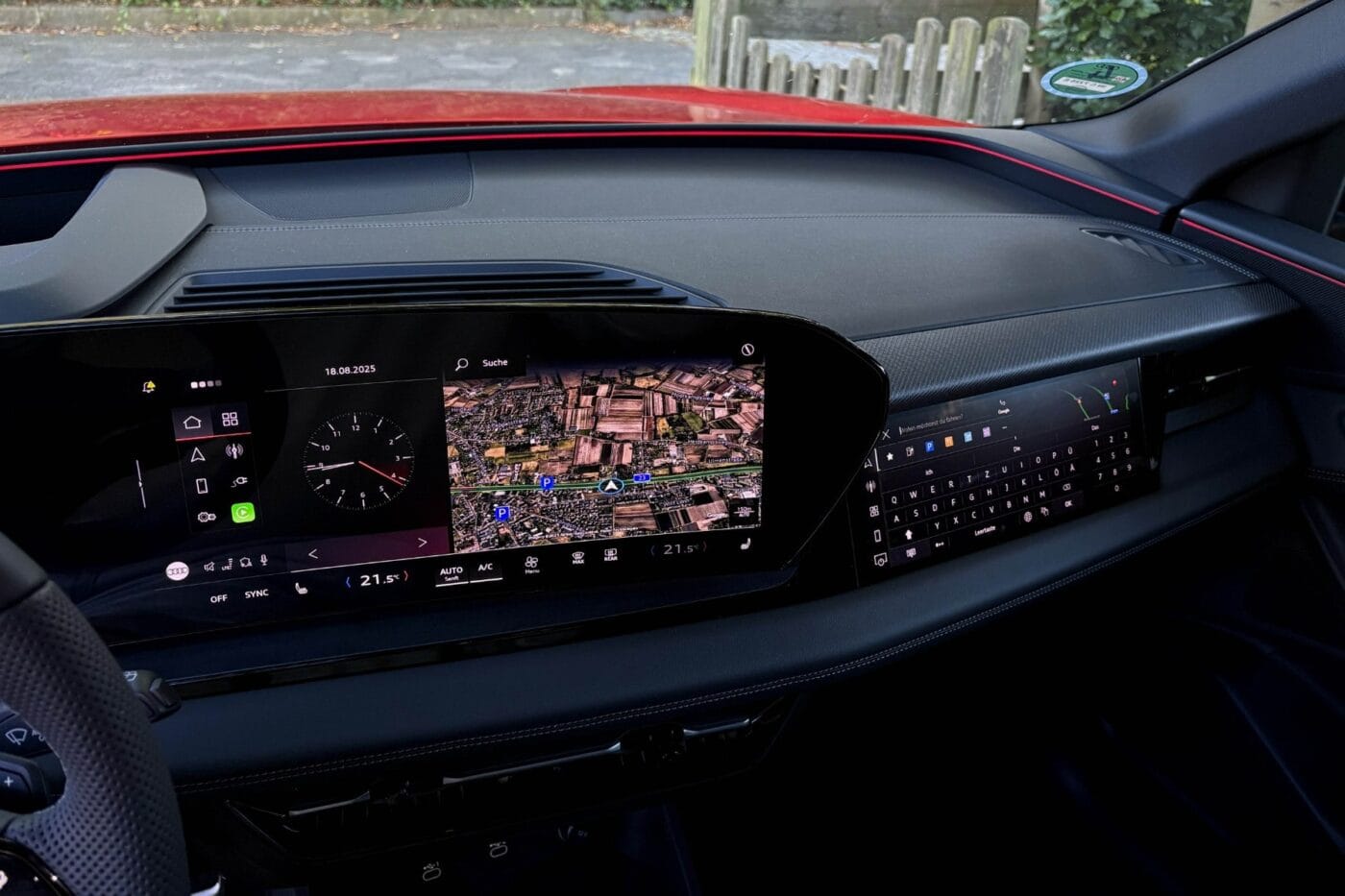
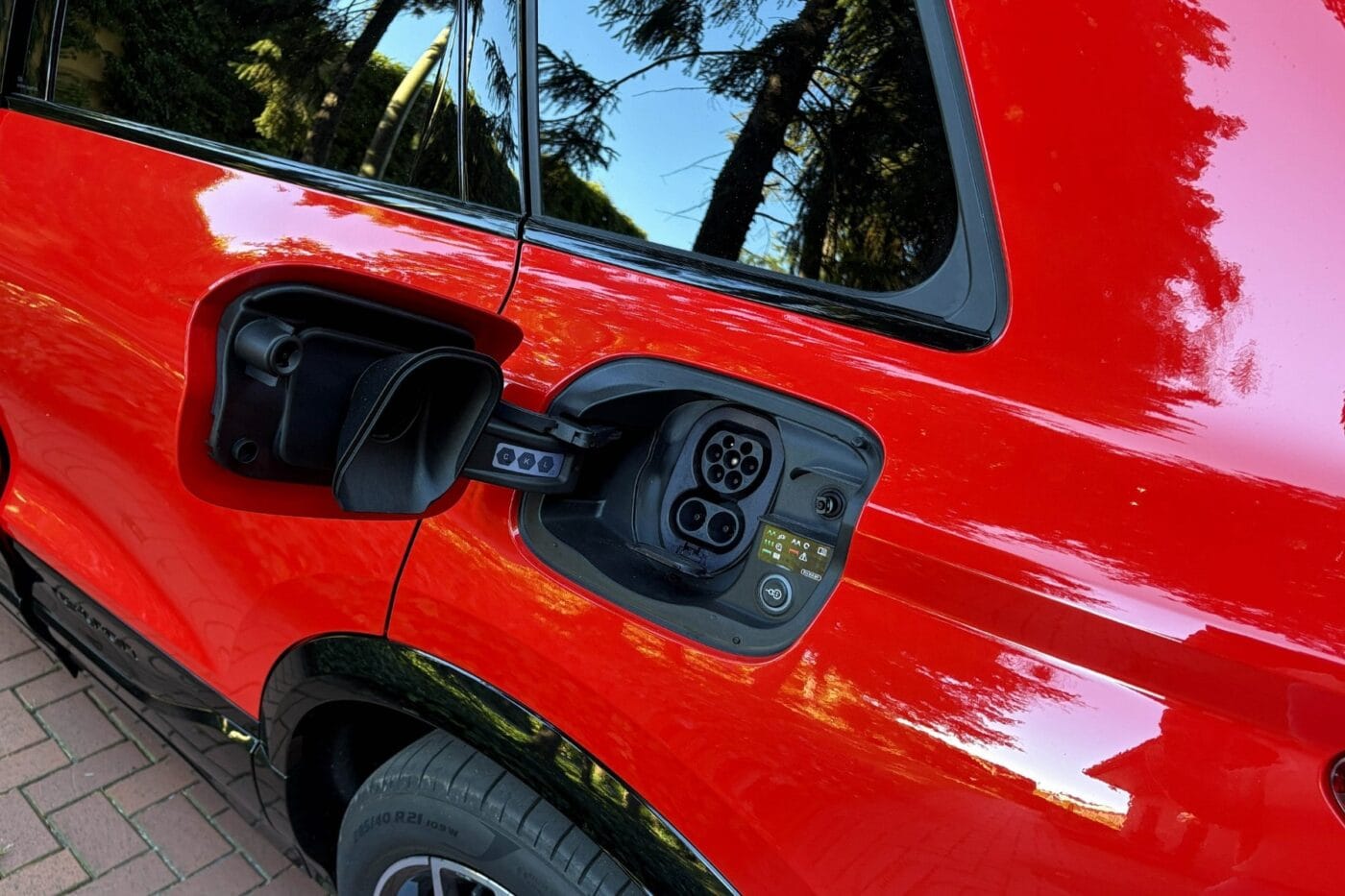
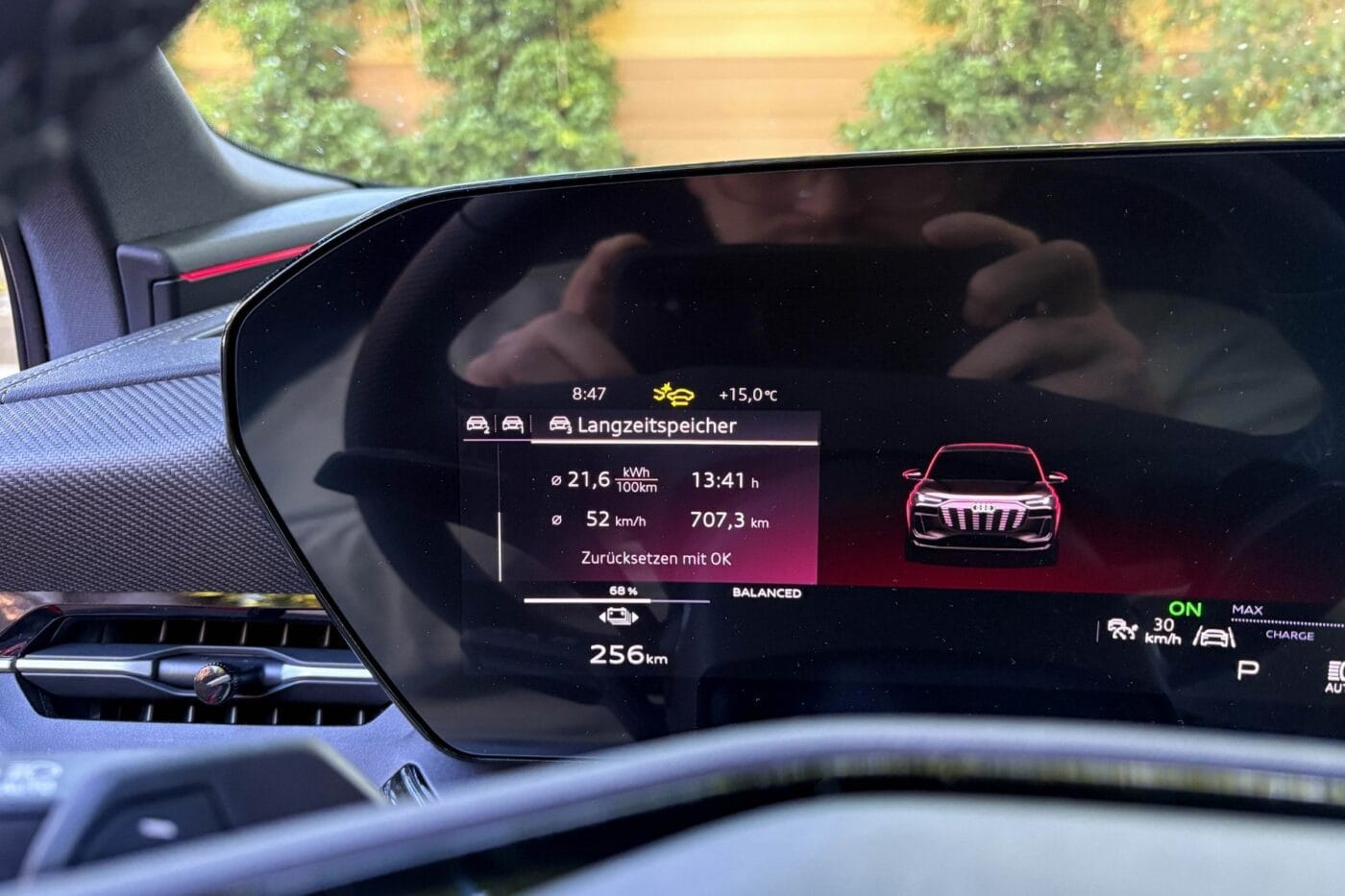
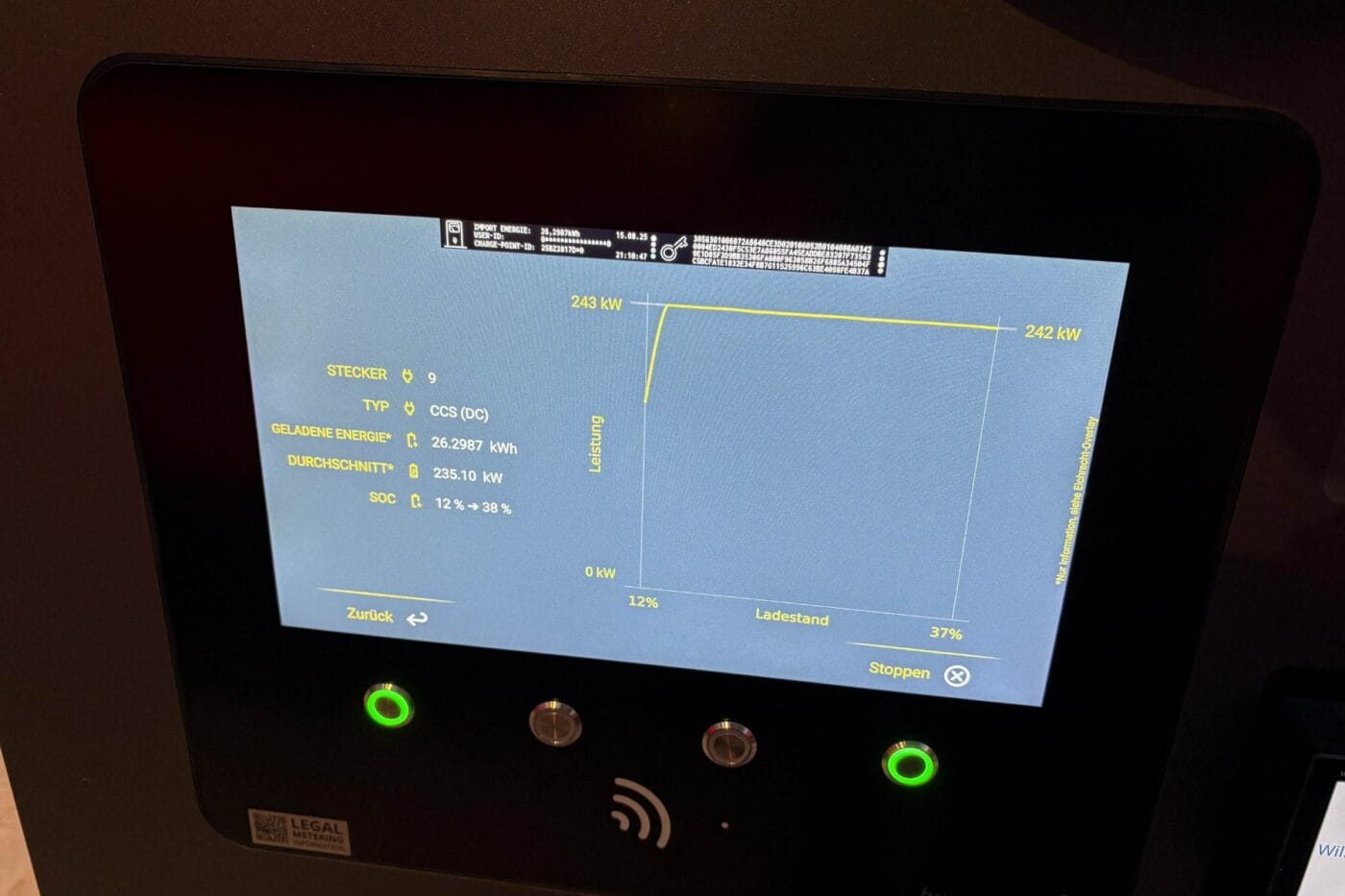
Interior
Audi says the interior has been designed “more consistently than ever before” around customer needs. It’s not a complete revolution, but the change is immediately visible. The most striking difference: the 11.9-inch driver display of the ‘Audi virtual cockpit’ and the new 14.5-inch MMI touchscreen for infotainment now form a single unit. Gone is the fragmented dashboard layout. The touchscreen, designed as a curved display, tilts slightly towards the driver. The right edge remains within easy reach. Both screens share a single frame that echoes the shape of the Singleframe grille – a nice touch that continues the design theme inside.
An optional smaller passenger display complements the driver-focused layout, allowing the front passenger to control key functions without stretching. The omission of physical climate controls makes for a tidy cabin design, though it would be more practical for operation. Still, the controls are easy to find – the climate menu is permanently located at the bottom of the touchscreen. Why Audi decided to fit such a large control panel in the driver’s door remains a mystery. The buttons aren’t especially user-friendly either. The same goes for the steering wheel controls: they react not only to presses but also to swipes, which can lead to unintended actions.
The rest of the interior leaves a similarly mixed impression. On the one hand, the high-quality seats offer excellent comfort, and overall build quality meets the premium standards one expects from Audi. On the other hand, the pressure to save costs shows in some areas – too much hard plastic for this price range. Nevertheless, Audi has, in my view, successfully modernised the cockpit in a logical way.
The new electric DNA
Driving feel has always been Audi’s strong suit, whether in terms of comfort or sportiness. The technical foundation of the Q6 e-tron is the ‘Premium Platform Electric’, which supports several variants: from a rear-wheel-drive version with 185 kW, through a stronger 225 kW version, up to the tested Q6 e-tron quattro with 285 kW. Above that sits the SQ6 e-tron with 380 kW of system output.
The tested all-wheel-drive Q6 e-tron accelerates from 0 to 100 kph in 5.9 seconds and is electronically limited to 210 kph. Only the SQ6 is more dynamic, sprinting to 100 kph in 4.3 seconds and reaching 230 kph. Compared with rivals, Audi can’t quite claim ‘Vorsprung durch Technik’ here. For context: the upcoming BMW iX3 does the sprint in 4.9 seconds, the electric GLC in 4.3 seconds, the Smart #5 Brabus in 3.8 seconds and the Tesla Model Y Performance – on paper – in just 3.5 seconds.
In everyday driving, those figures barely matter. The Q6 e-tron never feels underpowered. From the first few metres, the fine-tuned interplay between powertrain, suspension and steering becomes clear. The optional air suspension works lightning-fast: each wheel is adjusted individually within milliseconds. It filters bumps and potholes with ease, yet stiffens in corners for greater control. The steering feels precise and direct.
A particular highlight: the calm inside the Q6 e-tron, even at high speeds. Hardly any wind or tyre noise penetrates the cabin. Yes, that’s typical for Audi – but it remains impressive every time.
Finally more efficient
Efficiency, however, is where the Q6 e-tron truly surprises. Previous Audi EVs were not known for frugality. Getting their consumption below 20 kWh/100 km was often difficult. The Q6’s engineers clearly improved this. The all-wheel-drive model uses a 100 kWh battery (94.9 kWh net) that, depending on specification, enables up to 623 kilometres of WLTP range.
At temperatures between 19 and 23 degrees, I recorded between 18 and 19.5 kWh/100 km in city and country driving. On mixed routes with motorway sections, consumption rose to about 21–22 kWh/100 km; on mostly motorway trips, 22–24.5 kWh/100 km. That translates to real-world ranges of roughly 380 to 520 kilometres, depending on route and driving style – respectable for an all-wheel-drive SUV of this class, and very good by Audi standards.
Charging & route planning
Eventually, every battery runs low, and it’s time to plug in. With its 11 kW onboard charger, the Q6 e-tron can be fully charged in about ten hours. Audi doesn’t offer a 22 kW option. DC charging is faster. The PPE’s 800-volt system allows up to 270 kW DC charging in the Q6 e-tron quattro. The standard 10-to-80 per cent charge takes around 21 minutes. In terms of relative charging speed versus capacity, the Q6 e-tron ranks mid-pack within Audi’s range (the e-tron GT is faster) and among competitors – but still performs solidly. A deep dive into the Porsche Cayenne showed that the PPE platform can do even better: its 108 kWh battery can handle up to 400 kW, completing a 10–80 per cent charge in under 16 minutes.
Back to the Q6: during my measurement, it started at 185 kW with a 5 per cent state of charge (SoC), hit 269 kW at 7 per cent, and even peaked at 283 kW – above the official maximum. Only above 35 per cent did the curve start to drop. At 50 per cent – reached in under ten minutes – the power briefly rose again before tapering off. Even at 80 per cent, 114 kW were still available.
The data sheet figures, therefore, hold true in practice – and are reproducible. The automatically activated battery preconditioning, triggered when a fast charger is set as a destination in the navigation system, also helps. The MMI central display can show the battery temperature – a useful feature. The ideal range, says Audi, lies between 25°C and 45°C. What’s missing is an indication of the current available charging power. Nor can preconditioning be started manually – something Audi could fix with an update.
You can also set in the infotainment system how much charge you want to arrive with at a charging stop or destination – not every manufacturer offers this. The ‘e-tron route planner’ actively selects suitable charging stations along your route, with filters for different power levels: from 50 kW, 100 kW and 150 kW. Oddly, there’s no filter for above 250 kW – on a car that itself charges at 270 kW.
Infotainment and operation
The infotainment system also shows clear progress compared to previous Audi EVs. The MMI reacts quickly, menus are mostly well-structured and logically arranged, and many functions are only a few taps away. It’s also handy that the legally required acoustic speed warning can be switched off with a single button press.
A few nested submenus remain, but not many. More annoying are the endless legal disclaimers reminding you to keep your eyes on the road – even on the passenger display. What’s missing, however, is the navigation map in the driver information display behind the steering wheel.
Driver assistance & recuperation
The numerous driver assistance systems – listing them all would take too long – work reliably, as expected from Audi. There’s room for improvement in the lane-keeping assistant, which doesn’t always stay perfectly centred and sometimes oscillates slightly. On the positive side, recuperation works very well. In D-mode, the Q6 e-tron offers three levels adjustable via paddles on the steering wheel. Only in B-mode does it allow genuine one-pedal driving. Alternatively, in automatic mode, the car manages recuperation itself, using data from the navigation system, including gradients, curves, town signs, speed limits and traffic ahead. The system works smoothly and predictably.
| Q6 e-tron | Q6 e-tron Performance | Q6 e-tron quattro | |
|---|---|---|---|
| Drive | RWD | RWD | AWD |
| Power output | 185 (210) kW | 225 (240) kW | 285 kW |
| Acceleration | 7.6 (7.0) s | 6.7 (6.6) s | 5.9 s |
| Top speed | 210 kph | 210 kph | 210 kph |
| WLTP range | 484–546 km | 582–657 km | 562–637 km |
| Battery (gross) | 83 kWh | 100 kWh | 100 kWh |
| Battery (net) | 75.8 kWh | 94.9 kWh | 94.9 kWh |
| Charging capacity AC | 11 kW | 11 kW | 11 kW |
| Charging time AC (0-100 %) | 8 h | 10 h | 10 h |
| Charging capacity DC | 225 kW | 260 kW | 270 kW |
| Charging time DC (10-80%) | 21 min | 22 min | 21 min |
| Price | 63,500 euros | 68,800 euros | 74,700 euros |
(Values in brackets: with Launch Control)
Space & practicality
All the digital helpers and assist systems would mean little if the Q6 e-tron weren’t also practical. At its debut, Audi claimed that the long wheelbase and flat floor without a driveshaft tunnel would create generous space and everyday usability – and that’s accurate. Space is ample, with plenty of head- and legroom front and rear. Even long journeys are relaxed.
The 64-litre frunk is pleasantly large, and the boot offers 526 to 1,529 litres of volume – entirely usable in daily life. The only drawback: the load floor isn’t completely flat with the seats folded down. On the plus side, towing capacity is 2.4 tonnes.
Conclusion
All of this, of course, comes at a price. The tested version starts at €74,700. Audi’s steep options policy remains. The frunk costs €260 extra. The passenger display is only included in the ‘Tech plus’ package for €6,500 – though that also includes the S sport suspension and ‘Comfort plus’ package. Only the ‘Tech pro’ package for €8,500 adds the adaptive air suspension and enhanced driver assistance.
Entry is slightly cheaper with the Q6 e-tron Performance – less power (225 kW), two tonnes of towing capacity, but greater range with the same battery, starting at €68,800. Those content with the 83-kWh battery (75.8 kWh net) and 185 kW motor can configure a Q6 e-tron from €63,500.
In the end, Audi has built a very competent electric SUV in the Q6 e-tron. Whether for families or company car drivers, it impresses with comfort, payload, strong charging performance and, by Audi standards, efficient consumption. There’s still room for improvement. To reach the very top, Audi will need to go a step further – in both price and technical edge.
Has Audi, with the Q6 e-tron, earned back its ‘Vorsprung durch Technik’ claim? In part, yes. But that’s thanks more to the platform’s potential – as shown by the upcoming Porsche Cayenne – than to this model itself. Because in the current competitive field, the electric SUV isn’t quite a technological leap ahead.


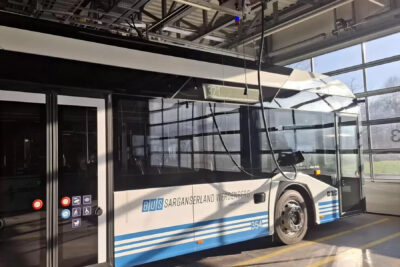

1 Comment